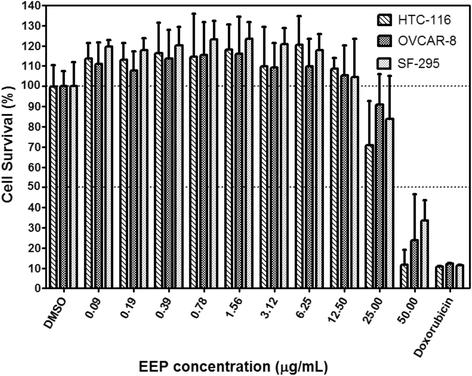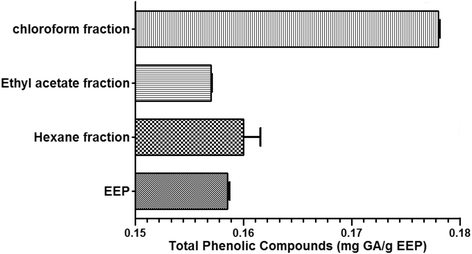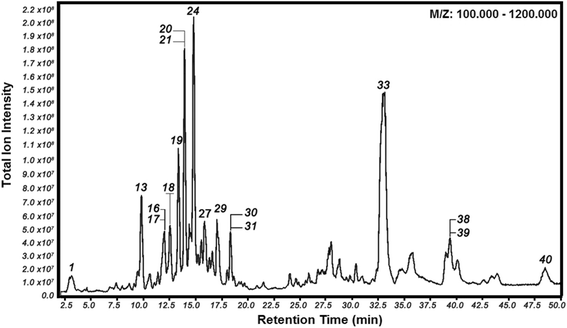Brazilian red propolis: phytochemical screening, antioxidant activity and effect against cancer cells
- PMID: 26467757
- PMCID: PMC4604764
- DOI: 10.1186/s12906-015-0888-9
Brazilian red propolis: phytochemical screening, antioxidant activity and effect against cancer cells
Abstract
Background: The implementation of new public healthcare models that stimulate the use of natural products from traditional medicine, as a so-called integrated medicine, refers to an approach that use best of both conventional medicine and traditional medicine. Propolis is a widely used natural product by different ancient cultures and known to exhibit biological activities beneficial for health. The large number of studies conducted with propolis had shown that its chemical composition differs as a function of the climate, plant diversity and bee species and plays an important role on its therapeutic properties. The aim of this study was to analyse the phytochemical profile of the ethanolic extract of red propolis (EEP) and its fractionation, antioxidant action of EEP and its fractions hexane, cloroform and ethyl acetate and cytotoxic activity of EEP on human tumour cell lines SF-295 (glioblastoma), OVCAR-8 (ovary) and HCT-116 (colon).
Methods: EEP was obtained by maceration with absolute ethanol, then it was concentrated in rotaevaporator up to complete evaporation of the solvent. The crude extract was fractionated with hexane, ethyl acetate, chloroform and methanol and they were subjected to phytochemical screening and total phenolic compounds. Antioxidant activity of EEP and fractions was done by means of the 2,2-diphenyl-1-picryhydrazyl (DPPH) method. Biomarkers of red propolis were identified by LC-Orbitrap-FTMS. To assess cytotoxic activity of the extract, cells were exposed to EEP over 72 h. Cell viability was assessed by means of MTT assay. The percentage of cell growth inhibition (IC50) was analysed by means of non-linear regression, and the absorbance values of the various investigated concentrations were subjected to one-factor analysis of variance (ANOVA) followed by Tukey's or Tamhane's tests (α = 0.05).
Results: The results obtained using phytochemical screening and LC-Orbitrap-FTMS indicated the presence of phlobaphene tannins, catechins, chalcones, aurones, flavonones, flavonols, xanthones, pentacyclic triterpenoids and guttiferones in Brazilian red propolis. EEP and its hexane, chloroform and ethyl acetate fractions obtained by liquid-liquid partitioning exhibited satisfactory antioxidant percentages. EEP (IC50 < 34.27 μg/mL) exhibited high levels of cytotoxicity on all human tumour cell lines tested when compared to negative control.
Conclusions: C-Orbitrap-FTMS was useful to establish the chemical profile of the red propolis. Brazilian red propolis has antioxidant properties and decreases substantially the percentage of cell survival of human tumour cells; thus, it has potential to serve as an anticancer drug.
Figures



Similar articles
-
Phytochemical screening and in vitro antibacterial, antifungal, antioxidant and antitumor activities of the red propolis Alagoas.Braz J Biol. 2019 Jul-Sep;79(3):452-459. doi: 10.1590/1519-6984.182959. Epub 2018 Oct 29. Braz J Biol. 2019. PMID: 30379200
-
Polyphenol profile by UHPLC-MS/MS, anti-glycation, antioxidant and cytotoxic activities of several samples of propolis from the northeastern semi-arid region of Brazil.Pharm Biol. 2017 Dec;55(1):1884-1893. doi: 10.1080/13880209.2017.1340962. Pharm Biol. 2017. PMID: 28631525 Free PMC article.
-
Apoptotic Potential and Chemical Composition of Jordanian Propolis Extract against Different Cancer Cell Lines.J Microbiol Biotechnol. 2019 Jan 28;30(6):893-902. doi: 10.4014/jmb.1905.05027. J Microbiol Biotechnol. 2019. PMID: 31752067 Free PMC article.
-
Antioxidant activity, antibacterial behavior, and anticancer impact of Egyptian propolis.Open Vet J. 2025 Jan;15(1):126-138. doi: 10.5455/OVJ.2025.v15.i1.12. Epub 2025 Jan 31. Open Vet J. 2025. PMID: 40092203 Free PMC article. Review.
-
Propolis: A Natural Substance with Multifaceted Properties and Activities.Int J Mol Sci. 2025 Feb 11;26(4):1519. doi: 10.3390/ijms26041519. Int J Mol Sci. 2025. PMID: 40003984 Free PMC article. Review.
Cited by
-
Red propolis reduces inflammation in cyclophosphamide-induced hemorrhagic cystitis in rats.Biomedica. 2022 Jun 1;42(2):253-263. doi: 10.7705/biomedica.6087. Biomedica. 2022. PMID: 35867919 Free PMC article.
-
Rheological and sensorial evaluation of yogurt incorporated with red propolis.J Food Sci Technol. 2020 Mar;57(3):1080-1089. doi: 10.1007/s13197-019-04142-5. Epub 2019 Nov 4. J Food Sci Technol. 2020. PMID: 32123429 Free PMC article.
-
Propolis: A Detailed Insight of Its Anticancer Molecular Mechanisms.Pharmaceuticals (Basel). 2023 Mar 16;16(3):450. doi: 10.3390/ph16030450. Pharmaceuticals (Basel). 2023. PMID: 36986549 Free PMC article. Review.
-
Comprehensive multivariate correlations between climatic effect, metabolite-profile, antioxidant capacity and antibacterial activity of Brazilian red propolis metabolites during seasonal study.Sci Rep. 2019 Dec 4;9(1):18293. doi: 10.1038/s41598-019-54591-3. Sci Rep. 2019. PMID: 31797960 Free PMC article.
-
Insects: an underrepresented resource for the discovery of biologically active natural products.Acta Pharm Sin B. 2017 Jul;7(4):409-426. doi: 10.1016/j.apsb.2017.05.001. Epub 2017 May 30. Acta Pharm Sin B. 2017. PMID: 28752026 Free PMC article. Review.
References
-
- Carvalho AC, Perfeito JPS, Silva LV C e, Ramalho LS, Marques RFO, Silveira D. Regulation of herbal medicines in Brazil: advances and perspectives. Braz J Pharm Sci. 2011;47:467–73.
-
- Tang XL. Protective effects of the ethanolic extract of Meliatoosendan fruit against colon cancer. Indian J Biochem Biophys. 2012;49:173–218. - PubMed
Publication types
MeSH terms
Substances
LinkOut - more resources
Full Text Sources
Other Literature Sources

